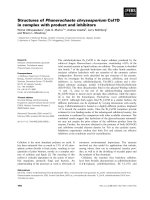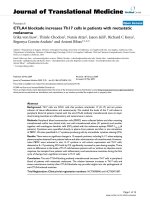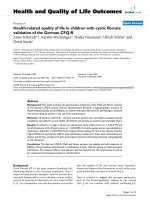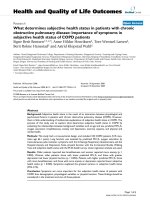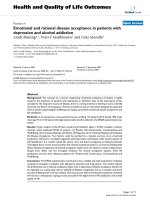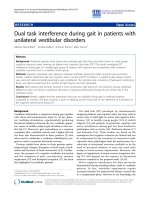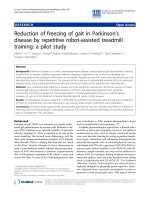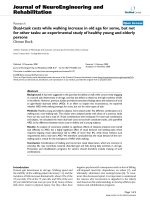Báo cáo hóa học: " Dual task interference during gait in patients with unilateral vestibular disorders" ppt
Bạn đang xem bản rút gọn của tài liệu. Xem và tải ngay bản đầy đủ của tài liệu tại đây (206.05 KB, 5 trang )
RESEARC H Open Access
Dual task interference during gait in patients with
unilateral vestibular disorders
Alberto Nascimbeni
1*
, Andrea Gaffuri
1
, Arminio Penno
2
, Mara Tavoni
3
Abstract
Background: Vestibular patients show slower and unsteady gait; they have also been shown to need greater
cognitive resources when carrying out balance and cognitive dual tasks (DT). This study investigated DT
interference during gait in a middle-aged group of subjects with dizziness and unsteadiness after unilateral
vestibular neuronitis and in a healthy control group.
Methods: Fourteen individuals with subacute unilateral vestibular impairment after neuronitis and seventeen
healthy subjects performed gait and cognitive tasks in single and DT conditions. A statistical gait analysis system
was used and spatio-temporal parameters were considered. The cognitive task, consisting of backward counting by
three, was tape recorded and the number of right figures was then calculated.
Results: Both patients and controls showed a more conservative gait during DT and between groups significant
differences were not found. A significant decrease in cognitive performance during DT was found only in the
vestibular group.
Conclusions: Results suggest that less attentional resources are available during gait in vestibular patients
compared to controls, and that a priority is given in keeping up the motor task to the detriment of a decrease of
the cognitive performance during DT.
Background
Vestibular information is important during gait together
with vision and somatose nsory input [1]. In fact, galva-
nic vestibular stimulation, experimentally producing
functional imbalance between the two vestibular appara-
tus, causes in healthy subjects gait deviation to the ano-
dal side [2]. Moreover, gait unsteadiness is a common
complaint after vestibular neuritis and a higher fall risk
has been also demonstrated in these patients [3] who
often need to undertake a vestibula r rehabilitation pro-
gram in order to promote functional recovery.
Previous studies have shown in these patients spatio-
temporal gait changes, disruption of head-trunk coordi-
nation and decrease of head movements [4-9]. Further-
more, the presence of a cognitive-vestibular interaction
and the complaint of poor concentration, memory
impairment [10] and disrupted navigation [11] has been
also highlighted in vestibular patients.
The dual task (DT) paradigm, by simultaneously
employing balance and cognitive tasks, has been used in
recent years to shed light on motor and cognitive inter-
ference [12] in healthy young people [13,14], elderly
subjects [15] and patients. In particular, cognitive and
motor interference during gait has been studied in
pathologies such as stroke [16], Parkinson disease [17]
and dementia [18]. These studies are based o n the
assumption that cognitive resources are limited and can
be undermined by the execution of concurrent tasks,
especially when pathologies limit the performance by a
reduction of attentional resources available or by the
need of increased attention to carry out usual tasks
owing to motor-sensory impairments. Moreover, the
degr ee of impairment of motor-sensory integration dur-
ing DT will depend on the amount of attentional
resources required by the proposed tasks [14,19].
Motor-cognitive interference has been previously
demonstrated during standing balance tasks in vestibular
patients. In fact, vestibular impairments require
increased attention for postural and balance control also
in a compensated phase. However to our knowledge, the
* Correspondence:
1
Rehabilitation Unit, S. Croce Hospital, Moncalieri Turin, Italy
Full list of author information is available at the end of the article
Nascimbeni et al. Journal of NeuroEngineering and Rehabilitation 2010, 7:47
/>JNER
JOURNAL OF NEUROENGINEERING
AND REHABILITATION
© 2010 Nascimbeni et al; licensee BioMed Central Ltd. This is an Open Access article distributed under the terms of the Creative
Commons Attribu tion License ( which permits unrestricted use, distribution, and
reproduction in any medium, provided the origina l work is properly cited.
possible DT interference during a common but more
attention requiring condition such as gait, has never
been studied before in vestibular patients. This issue is
of particular interest in the subacute phase, when vestib-
ular rehabilitation programs are usually carried out to
improve dynamic balance which in the activities of daily
living are commonly challenged by DT.
The main aim of this study was to explore DT interfer-
ence in a homogeneous group of patients with unilateral
vestibular impairment while performing backward count-
ing during gait, comparing the performances during sin-
gle and DT. A second aim was to find out differences if
any with an healthy control group. Since gait and balance
impai rments increase with age, together with the need of
attentional resources, causing more DT interferences
[12], older adults were not recruited in this study.
Methods
Participants
Patients and control subjects were included if their age
was between 18 and 65 years and without other patholo-
gies interfering with gait, balance and cognition. 14
patients with unilateral vestibular impairment after vestib-
ular neurit is and 17 healthy control subjects were evalu-
ated. Mean age, height and weight of the patient group,
made up of 8 female and 6 male, were 45.2 ± 8.1 years,
169 ± 9.8 cm and 66.4 ± 13.4 Kg while the v alues of the
control group, made u p of 13 female and 4 male, were
44.1 ± 7.9 years, 167 ± 10 cm. and 69.8 ± 14.3 Kg respec-
tively. The two groups did not result statistically different
for the aforementioned parameters. All patients enrolled
were referred for vestibular rehabilitation for enduring
complaints of dizziness or unbalance caused by the pre-
viousneuritis.Themeantimeelapsedfromtheacute
phase was 5.1 ± 6.2 months (range 1-24) and nervous sys-
tem suppressant medic ations were no m ore used at the
time of the assessment. The patients were first assessed by
a neurotologist and underwent alternating binaural bither-
mal caloric stimulation, head positioning test and audio-
metry. Vestibular tests showed 7 patients with right and 3
with left hypofunction, 2 with right and 2 with left loss of
vestibular function. Brain MRI was also carried out in
order to rule out other vestibular or central nervous sys-
tem pathologies that can affect balance such as cerebello-
pontine angle or white matter diseases. As these tests did
not demonstrate any other pathologies, the diagnosis of
peripheral unilateral vestibular impairment was confirmed.
All patients filled in a Dizziness Handicap Inventory
(DHI) questionnaire for disability assessment (median
50, range 20-80).
All subjects signed a written informed consent and the
study was approved by the Orbassano A.S.O. San Luigi
Gonzaga Ethical Committee, conforming with Geneva
convention.
Tasks and procedures
The motor single task consisted of walking at self
selected speed, back and forth in a well-lit gait labora-
tory without stopping. The distance between each turn
was of 12 m. The cognitive single task consisted of
backward counting aloud by 3 while the subjects were
comfortably seated. During DT participants were asked
to walk while backward coun ting without any prioritiza-
tion of cognitive or motor task, and to carry out the test
to the best of their abilities. In case of miscalculations,
they wer e instructed to continue co unting from the last
spoken digit.
Each participant performed three trials. Before the
beginning of the test, participants carried out a walking
practice trial of about 1 minute wearing gait analysis
sole sensors and performed a brief counting practice,
showing to have understood the task. The order of the
trials was randomised and each trial lasted one minute.
Each participant underwent all test conditions during
the same day.
STEP 32 gait analysis system (DEM Italia, Leinì,
Turin, Italy) was employed for gait assessment. Phases
of contact of the feet with the ground on a three l evel
scale (heel, sole and forefoot) were acquired from three
adhesive footswitches placed under the first and fifth
metatarsal head and under the posterior part of the heel
of each bare foot. The acquired data were offline statisti-
cally processed by the system software. The sampling
rate was of 2 KHz and footswitches closing strength was
of 3 N. The statistical gait analysis system employed
allows atypical gait patterns such as those recorded dur-
ing turns and acceleration-deceleration phases to be
excluded from analysis. The parameters evaluated were:
foot contact (FC), defined as the stride phase percentage
in which all three foot switches were in contact with the
ground, swing (Sw) and double support (DS) percen-
tages of stride, stride t ime (ST) and coefficient of var-
iance of stride time (CV). CV was calculated as the
percentage of the quotient between standard deviation
and stride time mean (CV = [SD/ST mean] × 100). For
each gait parameter the mean value of right and left
sides was calculated and used for statistical analysis.
The cognitive task consisted of backward counting by
three, starting from 300. Previous studies demonstrated
this cognitive task as sufficiently challenging in DT even
in standing condition [14]. Single cognitive task and DT
were tape recorded and the number of correct calcula-
tions were considered for further analysis.
Data analysis
Mean values and standard deviations (SD) were used for
gait parameters and cognitive performance. A paired
t-test was used to assess gait and cognitive parameters
changes between single and DT conditions within
Nascimbeni et al. Journal of NeuroEngineering and Rehabilitation 2010, 7:47
/>Page 2 of 5
groups. An independent t-test was employed for
between groups g ait parameters comparisons in single
and DT conditions. Owing to small sample groups sepa-
rate t-test were chosen instead of ANOVA analysis and
between groups analysis for the cognitive variable was
not carried out for the same reason.
Normality of data distribution was verified with curto-
sis and skewness tests. When data distribution was not
normal, Wilcoxon or Mann Whitney test were used
accordingly. A value of p < 0.05 was deemed significant.
Considering that 22 statistical tests were carried out, a
Bonferroni correction was made to compensate for
alpha inflation and a test-wise p <0.002wasthen
accepted. The statistics were performed using Stat-
graphics Centurion software, release XV.
Results
All patients and controls carried out the tasks properly.
The analysis of gait parameters (Table 1) showed a sig-
nificant increase of FC (patients p < 0.0005, controls p <
0.002), DS (patients p < 0.0001, controls p < 0.0007) and
a significant decrease of Sw (patients p < 0.0005, con-
trols p <0.001)fromsingletasktoDTinbothgroups.
Even though patients had higher mean values of FC, DS,
ST and CV and lower mean values of Sw in b oth single
and DT conditions than controls, these differences did
notresultsignificantwhenbetween-group comparisons
were performed.
For both groups, mean values of number o f correctly
enumerated figures during the cognitive task were higher
under single task (patients: 22.85 ± 10.90, controls: 22.47 ±
9.28) than DT (patients:17 ± 9.33, controls: 19.76 ± 9.04).
The total num ber of enumerated fi gures was also higher
under single task (patients: 23.64 ± 10,53, controls: 23,71 ±
8,7) than DT (patients: 18.57 ± 8.83, controls: 21.18 ±
8.11). The within group differences between single and DT
were significant for the patients group (p < 0.001) but not
for controls (p = 0.034).
Discussion
This study investigated cognitive and motor interference
during gait in vestibular patients complaining of
persistent dizziness and unsteadiness after unilateral ves-
tibular neuritis. We decided to exclude from the study
elderly subjects in order to rule out the effects of aging
as previously suggested [20]. The main finding was that
patients demonstrated a significant worsening of back-
ward counting during gait, compared to backward
counting in single task (carried out while seating),
whereas the control group showed only a non significant
trend in this direction. In regard to the gait task, both
groups had a more conservative gait during DT. More-
over, the vestibular group showed a trend of higher
mean values for FC, DS, ST and CV and lower values
for Sw in both single a nd DT conditions than controls,
even if between groups differences were not stat istically
significant.
The decreased cognitive performance of patients in
DT suggests that more attentional resources are needed
to cope with an unbalanced vestibular input during gait,
causing motor-sensory integration disruption. In a con-
dition of perceptual difficulty and cognitive overload,
available attention is prioritized towards the gait task
which is not significantly hindered, to the detriment of
the cognitive task. In both groups the findin g of signifi-
cant gait changes of FC, DS and Sw between single and
DT indicates the use of a more conservative gait when a
demanding cognitive task is overloading attentional
resources. This behaviour does not result to specifically
involve vestibul ar patients, but it is also present in
healthy participants even if with borderline statistical
significance.
Our findings partially agree with previous gait analysis
studies that demonstrated a disrupted gait pattern in ves-
tibular patients. Greater foot pressure on the side of the
lesion has been found in unilateral vestibular patients
during gait with eyes closed [4]. Vestibular subjects were
found to have increased ST and DS, lower gait speed and
cadence [6,21] and higher interfoot distance during paced
gait but only at increased speed [22]. The use of a trunk
strategy for head stabilization, in order to compensate for
a disrupted vestibulo-ocular reflex [5,7,8], and a decrease
of head rotations while walking in dark was also demon-
strated [9]. However, in our study, the between-groups
Table 1 Gait parameters values in each task by group, mean ± standard deviation
Variables Patients Controls
Single task Dual task Single task Dual task
Foot contact (%) 37.85 ± 3.91 40.9 ± 4.47* 36.02 ± 5.56 37.77 ± 5.33*
Double support (%) 22.85 ± 4.59 26.28 ± 4.48* 23.06 ± 4.51 24.42 ± 4.66*
Stride time (S.) 1.16 ± 0.12 1.22 ± 0.17 1.12 ± 0.10 1.16 ± 0.08
Coefficient of variation of stride time (%) 3.07 ± 1.77 3.25 ± 0.87 2.42 ± 0.83 2.93 ± 1.03
Swing (%) 38.51 ± 2.30 36.73 ± 2.20* 38.42 ± 2.24 37.65 ± 2.38*
S.: seconds; *significant difference (p ≤ 0.002) between single and dual task within group.
CV: Coefficient of variation = [standard deviation/mean] × 100.
Nascimbeni et al. Journal of NeuroEngineering and Rehabilitation 2010, 7:47
/>Page 3 of 5
gait differences were not significant, but only a trend was
observed. This finding might be related to the type of our
sample that included only middle-aged patients with
unilateral vestibular impairment in a post-acute phase,
allowing to rule out aging effect and acute phase related
major balance disruption. Moreover, the gait analysis sys-
tem used recorded and statistically analysed longer peri-
ods of walking, allowing a better representation of the
more consistent individual gait pattern. Furthermore, CV
of ST was previously found to be increased in healthy
young subjects during DT [23] and greater SD of ST was
also demonstrated in vestibular patients during gait [24].
However, we did n ot find any significa nt differences of
CV: this observation might be explained by an inter-sub-
jects variability in gait behaviour in the vestibular group
as demonstrated by higher SD of CV in single task.
The priority of a postural strategy has been previously
highlighted in a healthy y oung population during a
standing and visual spatial memory DT [13]. On the
other hand, a backward counting task was found to be a
challenging task more than digit reversal and 2-bit clas-
sification tasks, increasing sway in healthy subjects
standing on a compliant surface [14].
Previous studies on DT in vestibular patients, carried
out with different balance and mental tasks and some-
times including peripheral and central balance impair-
ments, had not produced unambiguous results.
However, in agreement with our results, a decreased
mental performance has been often evidenced and
explained by a balance prioritization strategy. Longer
reaction times were found in patients with vestibular
balance disorders and controls in DT, with proportio-
nately longer times while executing more difficult balan-
cing tasks [19]. Both well compensated patients with
unilateral vestibular loss and controls showed increased
sway in DT but only patients had increased reaction
times [25]. Other authors did not find out any impair-
ment of a silent backward counting task during standing
in a middle-aged sample of patients with central and
peripheral balance dysfunction, but rather a decrease of
sway, suggesting balance prioritization [20]. The perfor-
mance of a visuospatial task deteriorated in both normal
and vestibular patients while performing a balance task.
However, a decrement in the cognitive performance and
increased sway during computerized dynamic posturo-
graphy was shown in patients with minor balance
impairment and controls, but less sway was found dur-
ing DT in patients with major balance problems [26],
perhaps because of enhanced arousal.
Conclusion
This stud y is in agreement with previous works suggest-
ing a balance prioritization during DT in vestibular
patients with a decrease of mental task performance.
This behaviour might be the consequence of higher cog-
nitive demands required to cope with unilateral vestibu-
lar impairment when multisensory integration and gaze
stabilization [27] is needed during motor tasks. For the
first time, our results extend this hypothesis to a more
demanding and daily motor task such as gait, requiring
greater multiple sensory integration. However, even if
statistically significant, the differences of cognitive
performance between the vestibular and the control
groups are small and the clinical relevance of the results
should be considered with caution.
Our findings, if confirmed in a greater sample, might
be useful when planning DT dynami c exerci ses in order
to improve DT performance in not well compensated
vestibular patients. Further research could be useful to
develop new strategies for rehabilitation and prevention
of falls through tailored training in dual task exercises.
Author details
1
Rehabilitation Unit, S. Croce Hospital, Moncalieri Turin, Italy.
2
E.N.T. Unit, S.
Croce Hospital, Moncalieri Turin, Italy.
3
Rehabilitation Unit, Martini Hospital,
Turin, Italy.
Authors’ contributions
AN was responsible for conception and design of the study, data analysis,
and article drafting. AP clinically assessed and included participants,
participating in the data discussion. MT and AG participated in data
collection and article drafting. All authors read and approved the final
manuscript.
Competing interests
The authors declare that they have no competing interests.
Received: 2 February 2010 Accepted: 20 September 2010
Published: 20 September 2010
References
1. Kennedy PM, Carlsen AN, Inglis JT, Chow R, Franks IM, Chua R: Relative
contribution of visual and vestibular information on the trajectory of
human gait. Exp Brain Res 2003, 153:113-7.
2. Fitzpatrick C, Wardman DL, Taylor JL: Effects of galvanic vestibular
stimulation during human walking. J Physiol 1999, 517:931-9.
3. Herdman SJ, Blatt P, Schibert MC, Tusa RJ: Falls in patients with vestibular
deficits. Am J Otol 2000, 21:847-51.
4. Ishikawa K, Cao ZW, Wang Y, Wong WH, Tanaka T, Miyzaki S, Toyoshima I:
Dynamic locomotor function in normals and patients with vertigo. Acta
Otlaryngol 2001, 121:241-4.
5. Patten C, Horak FB, Krebs DE: Head and body center of gravity control
strategies: adaptation following vestibular rehabilitation. Acta Otolaryngol
2003, 123:32-40.
6. Tucker CA, Ramirez J, Krebs DE, Riley PO: Center of gravity dynamic
stability in normal and vestibulopathic gait. Gait Posture 1998, 8:117-23.
7. Cavanaugh JT, Goldvasser D, Mc Gibbon CA, Krebs DE: Comparison of
head- and body-velocity trajectories during locomotion among healthy
and vestibulopathic subjects. J Rehabil Res Dev 2005, 42:191-8.
8. Mamoto Y, Yamamoto K, Imai T, Tamura M, Kubo T: Three-dimensional
analysis of human locomotion in normal subjects and patients with
vestibular deficiency. Acta Otolaryngol 2002, 122:495-500.
9. Pozzo T, Berthoz A, Vitte E, Lefort L: Head stabilization during locomotion.
Perturbations induced by vestibular disorders. Acta Otolaryngol Suppl
1991, 481:322-7.
10. Hanes DA, McCollum G: Cognitive-vestibular interactions: a review of
patient difficulties and possible mechanisms. J Vestib Res 2006, 16:75-91.
Nascimbeni et al. Journal of NeuroEngineering and Rehabilitation 2010, 7:47
/>Page 4 of 5
11. Peruch P, Borel L, Gaunet F, Thinus-Blanc G, Magnan J, Lacour M: Spatial
performance of unilateral vestibular defective patients in non visual
versus visual navigation. J Vestib Res 1999, 9(1):37-47.
12. Woollacott M, Shumway-Cook A: Attention and the control of posture
and gait: a review of an emerging area of research. Gait Posture 2002,
16:1-14.
13. Siu K, Woollacott M: Attentional demands of postural control: the ability
to selectively allocate information-processing resources. Gait Posture
2007, 25:121-6.
14. Pellechia GL: Postural sway increases with attentional demands of
concurrent cognitive task. Gait Posture 2003, 18:29-34.
15. Faulkner KA, Redfern MS, Rosano C, Landsittel DP, Studenski SA, Cauley JA,
Zmuda JM, Simonsick EM, Kritchevsky SB, Newman AB: Reciprocal
influence of concurrent walking and cognitive testing on performance
in older adults. Gait Posture 2006, 24:182-9.
16. Plummer-D’Amato P, Altmann LJP, Saracino D, Fox E, Behrman AL,
Marsiske M: Interactions between cognitive tasks and gait after stroke: a
dual task study. Gait Posture 2008, 27:347-51.
17. O’Shea S, Morris ME, Iansek R: Dual task interference during gait in
people with Parkinson disease: effects of motor versus cognitive
secondary tasks. Phys Ther 2002, 82:888-97.
18. Allali G, Kressig RW, Assal F, Herrmann FR, Dubost V, Beauchet O: Changes
in gait while backward counting in demented older adults with frontal
lobe dysfunction. Gait Posture 2007, 26:572-6.
19. Yardley L, Gardner M, Bronstein A, Davies R, Buckwell D, Luxon L:
Interference between postural control and mental task performance in
patients with vestibular disorder and healthy controls. J Neurol Neurosurg
Psychiatry 2001, 71:48-52.
20. Andersonn G, Hagman J, Talianzadeh R, Svedberg A, Larsen HC: Dual-task
study of cognitive and postural interference in patients with vestibular
disorders. Otol Neurotol 2003, 24:289-93.
21. Marchetti GF, Whitney SL, Blatt PJ, Morris L, Vance JM: Temporal and
spatial characteristics of gait during performance of the dynamic gait
index in people with and in people without balance or vestibular
disorders. Phys Ther 2008, 88:640-51.
22. Krebs DE, Goldwasser D, Lockert JD, Portney LG, Gill-Body KM: Is base of
support greater in unsteady gait? Phys Ther 2002, 82:138-47.
23. Beauchet O, Dubost V, Herrmann FR, Kressig RW: Stride-to-stride variability
while backward counting among healthy young adults. J Neuroeng
Rehabil 2005, 2:26.
24. Perring S, Summers T: Laboratory-free measurement of gait rhythmicity
in the assessment of the degree of impairment and the effectiveness of
rehabilitation in patients with vertigo resulting from vestibular
hypofunction. Physiol Meas 2007, 28:697-705.
25. Redfern MS, Talkowski ME, Jennings JR, Furman JM: Cognitive influences in
postural control of patients with unilateral vestibular loss. Gait Posture
2004, 19:105-14.
26. Andersonn G, Yardley L, Luxon L: A dual-task study of interference
between mental activity and control of balance. Am J Otol 1998,
19:632-7.
27. Whitney SL, Marchetti GF, Pritcher M, Furman JM: Gaze stabilization and
gait performance in vestibular dysfunction. Gait Posture 2009, 29:194-8.
doi:10.1186/1743-0003-7-47
Cite this article as: Nascimbeni et al.: Dual task interference during gait
in patients with unilateral vestibular disorders. Journal of
NeuroEngineering and Rehabilitation 2010 7:47.
Submit your next manuscript to BioMed Central
and take full advantage of:
• Convenient online submission
• Thorough peer review
• No space constraints or color figure charges
• Immediate publication on acceptance
• Inclusion in PubMed, CAS, Scopus and Google Scholar
• Research which is freely available for redistribution
Submit your manuscript at
www.biomedcentral.com/submit
Nascimbeni et al. Journal of NeuroEngineering and Rehabilitation 2010, 7:47
/>Page 5 of 5
